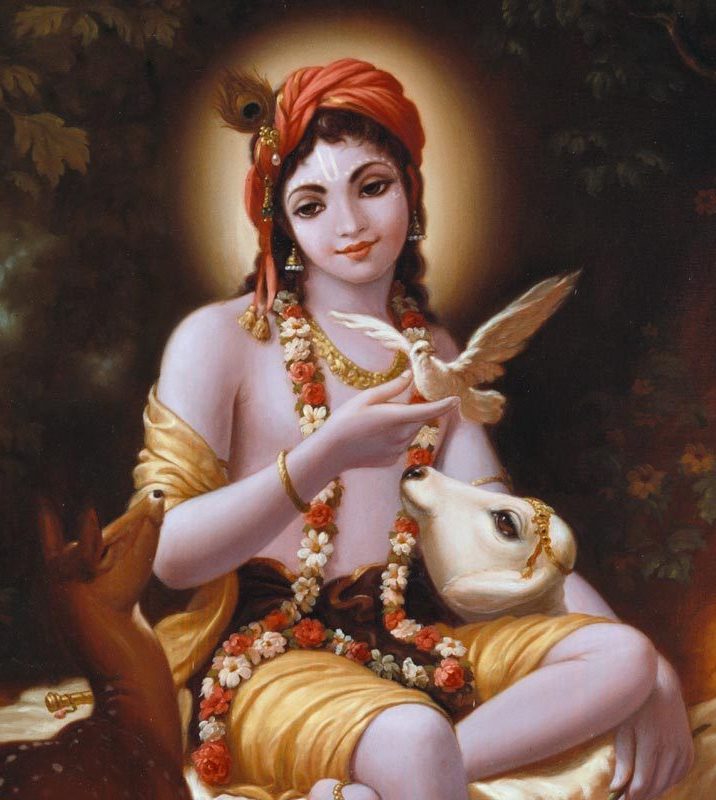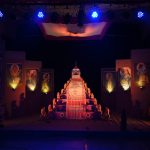Mahapurusha Madhavadeva’s Nām-Ghoshā is such a book that is at the same time collection of sweet hymns as well as a series of profound philosophical theories of Vivartanavāda pertaining to the Eka Sarana Nāma Dharma order founded by his preceptor Srimanta Sankaradeva. It is upto the readers to choose the objective in reading or reciting, whether to treat it as a philosophical treatise or a devotional scripture. That people all over Brahmaputra valley continue to drench themselves in the divine bliss of its verses speak volumes about its worth. Every activity of the followers of Srimanta Sankaradeva since morning till night is drenched in the shower of Nām-Ghoshā’s verses. While this is natural for the believers, what is more surprising is that even non-believers relish the verses of Nām-Ghoshā for their sheer beauty and sweetness.
The very first verse of Nām-Ghoshā is a marvellous composition, which contains almost the entire theoretical essence of Eka Sarana Nāma Dharma.
Muktita nispriha yito Sehi bhakataka namo
Rasamayee māgoho bhakati
Samasta mastaka mani nija bhakatara basya
Bhajo hena deva Yadupati (1)
Its meaning is : I pay obeisance to that devotee who is indifferent to salvation. I seek only the blissful devotion. I worship the Lord, the creator of all Yadu or the heroic ones and the cynosure of all beings, who is subservient to own devotees.
Mukti or salvation is the supreme objective of the seekers of truth in almost all orders in the multi-millenium old Sanātana religion. Mukti means merger of the Jiva or individual self in the Paramātmā or universal self whereupon the individual self loses its separate identity. Paramātmā is also known as Brahma. The concept of Mukti is an imperative in the Jnāna-mārga or the path of knowledge. However the Bhakti-mārga or the path of devotion does not talk about merger in Brahma. Rather it talks about relishing the bliss or the supreme happiness that one can expect from devotion to Ishwara or God, who is the attributeful form of the attributeless Brahma. The Ishwara is presented as the creator, but also at the same time who can be felt at Mastaka. This hints at ascent of the Jiva through the ascent of Kundalini and merger with Brahma at Brahma-randhra. It amounts to equating Brahma and Ishwara, which was theorised by Madhavadeva’s preceptor Srimanta Sankaradeva in Kirttana-Ghoshā. So the disciple establishes the hypothesis of his preceptor in this verse.
The second verse of Nām-Ghoshā is a practical way about how to achieve the goal outlined in the outset.
Yāra Rāma Krishna nāma nāwe bhava sindhu tari
Pāwe parama pada pāpee yata
Sadānanda sanātana henaya Krishnaka sadā
Upāshā karoho hridayata (2)
Its meaning is : I worship in my heart that lord Krishna, who is eternal and who is the embodiment of bliss, and whose names ‘Rama’ and ‘Krishna’ are means to redeem even the sinner from the mundane life of woes.
Ishwara is named as ‘Rama’ and ‘Krishna’ in this verse. They are believed to be incarnations of Ishwara in the Sanātana religion. But this verse highlights the essential characteristic of bliss Sadānanda rather than their mythological narratives. So it is abundantly clear that Ishwara is none but Brahma. The names ‘Rama’ and ‘Krishna’ are means for the Jiva transcending the mundane life. It is categorically spelled out when the litterateur terms these names as boat to carry the Jiva across the mundane life. Why the order is named Nāma Dharma can also be explained in this verse. Clearly the philosophy propounded in the first verse is embedded in the religious order according to the second verse. Even the absence of idolatry is defined here by specifying that the image of Ishwara should be in the devotee’s heart. Thus Madhavadeva tells the world that the order founded by his preceptor Srimanta Sankaradeva is a logical one, which has no contradiction at all with the propounded philosophy.
The eighth verse is further explanation about the identity of Ishwara and Brahma. The narrative used for Ishwara in this verse is what is used for Brahma.
Avyakta Ishwara Hari kimate pujibā tānka
Vyāpakata kibā visarjana
Etāvanta murti shunya kenamate chintibāhā
Rāma buli shuddha karā mana (8)
Its meaning is : Ishwara Hari is non-manifest so as to be worshipped. Any personification will be only deminution of Him. As this formless Ishwara is beyond perception, one should purify one’s mind by uttering the name ‘Rama’.
The attributes used for Ishwara in this verse are non-manifest, lack of personification and formless. All these are also the features of Brahma. So Madhavadeva elucidates the identity of Ishwara and Brahma here. Just as Brahma is only a concept, Ishwara is also a concept, which is named as Rama. This name is only an attributeless tool for one to elevate oneself. Thus Ishwara and Brahma merge in this name. One can get a fair glimpse into the philosophy of Vivartanavāda from this verse.
The forty seventh verse of Nām-Ghoshā elucidates the nature of Jiva and other creations.
Māyā ādi kari yata samaste jagata jara
Krishnese chaitanya ātmā shuddha (47)
Its meaning is : The entire creation, including the Māyā (illusion) is insentient. Only Krishna is the consciousness and pure soul of every being.
Madhavadeva implies here that Ishwara is embedded in all beings in the creation and makes the entities sentient. Without that embedded consciousness everything in the creation are insentient. As mentioned repeatedly, Krishna is the name of Ishwara. So when the author says that Krishna is the consciousness and pure soul of every being, he says that Ishwara exists in every being as inner consciousness. If that inner consciousness coming from Ishwara is absent, all creations will be inert as these are nothing but illusions. Moreover the element of Māyā is not independent of Ishwara. Māyā does not exist without Ishwara.
The one hundred fortieth verse of Nām-Ghoshā is a philosophical analysis of the word Krishna used in the order to denote Ishwara.
Krish hena shabda ito prithivi bāchaka bhaila
Na ānandata pravartaya
Duiro eka pada bhaile parama Brahma rupa Krishna
Nāma ānandaka mātra kaya (140)
Its meaning is : The word ‘Krish’ implies the earth and the word ‘Na’ implies bliss. When both these words are joined together, it comes to imply ‘Krishna’, the embodiment of the universal self Brahma. It also means the bliss derived from chanting the name of Ishwara.
This verse amply proves that Krishna of Nām-Ghoshā is not merely the Krishna of Mahābhārata. The Krishna of Eka Sarana Nāma Dharma is such an embodiment of Ishwara who is at the same time Brahma. This Krishna is beyond attributes. Literary analysis of the name Krishna in this verse is proferred as a supporting argument of Brahma-Ishwara identity. Krishna is presented as synthesis of Krish and Na. Moreover the powerful nature of the name is sought to be conveyed here. If the word Krishna is so powerful that it is the embodiment of the universal self Brahma, certainly it is an immensely strong tool for the devotees in their spiritual exercise. This is the philosophy of Eka Sarana Nāma Dharma. By chanting the name of Ishwara, which happens to be Krishna in this case, the devotee realises the Brahma. This realisation comes in the form of bliss.
The one hundred fiftieth verse analyses the intrinsic nature of the five elements in nature and relates them with Ishwara.
Yi kārane Nārāyane panchabhute panchabarna
Mālā pindhi prakāsha karanta
Ehi hetu nirantare jānibāhā Banamāli
Nāma dhari āsā Bhagavanta (150)
Its meaning is : Lord Narayana appears in the five elements wearing a five-coloured garland. That is why Ishwara bears the name ‘Banamali’, all the people should know that.
The elements water-fire-air-space-soil are the five basic ingredients of all creations. So these are known as Pancha Mahābhuta. Wherever we see, we come across these five elements only. Since all creations are manifestations of Ishwara as the latter is embedded in them, the elements water-fire-air-space-soil are also necessarily manifestations of Ishwara. A corollary of this is that the creation is not worthless as implied in many religious orders, since it is nothing but a form of the supreme almighty Ishwara. The identity of creation and creator, which is an important feature of Vivartanavāda is indicated in this significant verse.
The one hundred sixty eighth verse speaks about space-time as tools, which are inadequate in the context of Ishwara.
Deshe kāle tānka ekowe prakāre
Karite napāre anta
Ehi hetutese Ishwarara nāma
Prasiddha bhaila Ananta (168)
Its meaning is : Time and space cannot define him completely by any means. That is why Ishwara is renowned as ‘Ananta’ or infinite.
This verse explains the inadequacy of conceptual tools like space-time to describe Ishwara. That Ishwara is beyond the dimensions of space-time is pointed out in order to drive home the point that it is difficult to perceive the concept of Ishwara with our finite human capacity. The very use of tools like space-time by Madhavadeva shows how modern he was for his time, because these tools are important in Physics even in modern times. But these tools are adequate for study of physical bodies made of Pancha Mahābhuta only. These are unable to describe Ishwara, who has infinite number of dimensions. Our perception does not go beyond the two dimensions of space and time whereas Ishwara contains infinite dimensions. The traditional analysis fails to define Ishwara. So the attribute of Ananta or infinite is used in the context of Ishwara.
Bibliography :
1. Nām-Ghoshā : the oriental gem, English rendering of Mahapurusha Madhavadeva’s Nām-Ghoshā, Translated by Dr Sanjib Kumar Borkakoti, Bani Mandir, Guwahati, First edition, 2006
2. Nām-Ghoshā bhāvārtha, by Dr Sanjib Kumar Borkakoti, Bani Mandir, Guwahati, First edition, 2010
3. Unique features of Srimanta Sankaradeva’s religious philosophy ‘Vivartanavāda’ : comparison with other Sanātana Hindu philosophies, by Dr Sanjib Kumar Borkakoti, https://www.sankaradeva.com/blogs/49




